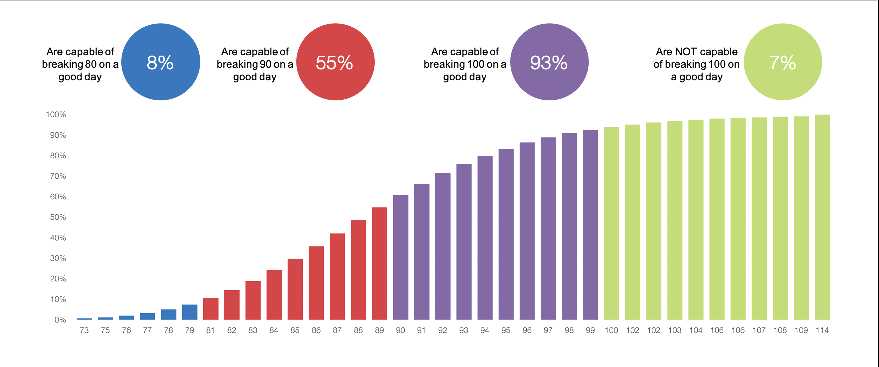Golf is a game of skill, strategy, and precision. One of the key elements that add a layer of fairness and competitiveness to the sport is the golf handicap. Whether you’re a seasoned golfer or a newcomer, understanding what a golf handicap is and how it works can enhance your enjoyment of the game. This guide will walk you through the basics of golf handicaps, how to calculate them, and how they work in practice.
Table of Contents
What is a Golf Handicap?
A golf handicap is a numerical measure of a golfer’s potential ability. It allows players of varying skill levels to compete on an equal footing. The lower the handicap, the better the golfer. Essentially, the handicap system adjusts a player’s score to reflect their skill level, enabling fair competition among players with different abilities.
Key Terms
- Gross Score: The total number of strokes taken during a round.
- Net Score: The gross score minus the player’s handicap.
- Course Rating: A number that indicates the difficulty of a course for a scratch golfer (a golfer with a handicap of 0).
- Slope Rating: A number that indicates the difficulty of a course for a bogey golfer (a golfer with a handicap around 20 for men and 24 for women) compared to a scratch golfer.
What Does Handicap Mean in Golf?
In golf, the handicap is a tool that levels the playing field. It means that a less skilled player gets a numerical advantage over a more skilled player. For example, if Player A has a handicap of 5 and Player B has a handicap of 20, Player B gets a 15-stroke advantage over Player A. This system ensures that players of different skill levels can compete fairly.
How to Calculate Golf Handicap
Calculating a golf handicap involves several steps and requires some key information. Here’s a simplified explanation of the process:
1. Determine Your Handicap Differential
The handicap differential is calculated for each round of golf you play. The formula is:
Handicap Differential = (Gross Score – Course Rating) × 113 / Slope Rating
2. Use the Best Differentials
To find your official handicap, you typically use the best 10 of your last 20 handicap differentials. If you have fewer than 20 scores, different rules apply.
3. Average the Differentials
Once you have your best differentials, you average them and multiply by 0.96 (the USGA recommends this to maintain a standard).
Example Calculation
Let’s break this down with an example:
- Gross Score: 90
- Course Rating: 72
- Slope Rating: 130
Handicap Differential = (90 – 72) × 113/130 = 18 × 113 / 130 = 15.65
If this is one of your best 10 scores, you would average it with the other best differentials and multiply by 0.96 to get your handicap index.
Example Handicap Differential Calculation
| Gross Score | Course Rating | Slope Rating | Handicap Differential |
|---|---|---|---|
| 90 | 72 | 130 | 15.65 |
| 85 | 71 | 128 | 12.47 |
| 88 | 70 | 135 | 15.01 |
How Does Handicap Work in Golf?
Handicaps work by adjusting each player’s score to a common level, allowing players of different skill levels to compete fairly. Here’s how it typically works in practice:
- Determine Each Player’s Course Handicap: Convert each player’s handicap index to a course handicap based on the specific course’s slope rating.
- Adjust Scores: Apply each player’s course handicap to their gross score to get their net score.
- Compare Net Scores: The player with the lowest net score is the winner.
Example of Handicap in Action
Imagine a match between Player A (handicap 5) and Player B (handicap 20). They play a round on a course with a slope rating of 113.
- Player A’s gross score: 80
- Player B’s gross score: 95
Player A’s net score = 80 – 5 = 75
Player B’s net score = 95 – 20 = 75
In this case, both players end up with the same net score, making the match competitive despite the difference in their skill levels.
Benefits of the Handicap System
- Fair Competition: Allows golfers of different skill levels to compete on an equal basis.
- Track Improvement: Provides a benchmark for tracking your progress and improvement over time.
- Enhances Enjoyment: Makes the game more enjoyable by creating competitive matches regardless of skill disparity.
Frequently Asked Questions (FAQs)
Q1: Can I have a negative handicap?
Yes, if a golfer consistently scores better than the course rating, they can have a negative handicap, indicating they are better than a scratch golfer.
Q2: How often should I update my handicap?
It’s recommended to update your handicap regularly, ideally after every round, to keep it accurate and reflective of your current playing ability.
Q3: Does every golf course have a different slope rating?
Yes, each golf course is rated differently based on its difficulty. The slope rating adjusts your handicap based on the course’s specific challenges.
For more helpful guides and tips on golf and other sports, stay tuned.

